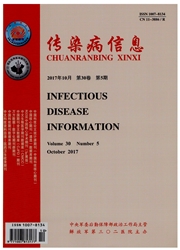

 中文摘要:
中文摘要:
目的:调查不同人群中新型呼肠病毒既往感染情况。方法选取健康人群以及手足口病、腹泻、麻疹、乙型肝炎等患者的血清标本,利用微量中和试验检测其血清标本中新型呼肠病毒IgG抗体。结果中和试验结果表明,健康人群中新型呼肠病毒IgG抗体阳性率为29.90%,抗体滴度的中位数为1∶32;手足口病患者中抗体阳性率为70.83%,抗体滴度的中位数为1∶64;乙型肝炎和麻疹患者抗体阳性率分别为90.22%和90.70%,抗体滴度的中位数均为1∶128;腹泻患者中抗体阳性率和抗体滴度的中位数均最高,分别为100%和1∶256。结论健康人群与不同疾病患者中新型呼肠病毒特异性IgG抗体阳性率及滴度存在显著差异。
 英文摘要:
英文摘要:
Objective To evaluate the prevalence of past infection with a novel reovirus in different populations. Methods The serum samples were taken from 97 healthy people and 219 patients with hand, foot and mouth disease (HFMD), diarrhea, measles and hepatitis B treated in our hospital. The prevalence of the novel reovirus-specific IgG antibody in sera was detected by using a neutraliza-tion assay. Results The neutralization assay demonstrated that the positive rates of the novel reovirus-specific IgG antibody were 29.90%in healthy controls, 70.83%in HFMD group, 90.22%in hepatitis B group, 90.70%in measles group and 100%in diarrhea group, and the median IgG antibody titers were 1∶32, 1∶64, 1∶128, 1∶128 and 1∶256 in those groups respectively. Conclusions The positive rates and titers of a novel reovirus-specific IgG antibody are significantly different between the healthy population and patients with different diseases.
 同期刊论文项目
同期刊论文项目
 同项目期刊论文
同项目期刊论文
 期刊信息
期刊信息
